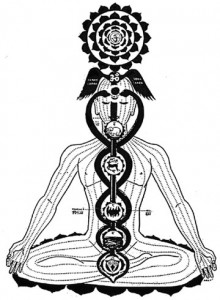“Kundalini Yoga consists of active and passive asana-based kriyas, pranayama, and meditations which target the whole body system (nervous system, glands, mental faculties, chakras) to develop awareness, consciousness and spiritual strength.”
“Kundalini yoga” in the 20th century, after a technical term peculiar to this tradition, has otherwise been known as laya yoga (लय योग), from the Sanskrit term laya “dissolution, extinction”. The Sanskrit adjective kuṇḍalin means “circular, annular”. It does occur as a noun for “a snake” (in the sense “coiled”, as in “forming ringlets”) in the 12th-century Rajatarangini chronicle. Kuṇḍa, a noun with the meaning “bowl, water-pot” is found as the name of a Naga in Mahabharata 1.4828. The feminine kuṇḍalī has the meaning of “ring, bracelet, coil (of a rope)” in Classical Sanskrit, and is used as the name of a “serpent-like” Shakti in Tantrism as early as c. the 11th century, in the Śaradatilaka. This concept is adopted as kuṇḍalni as a technical term into Hatha yoga in the 15th century and becomes widely used in the Yoga Upanishads by the 16th century.
Kundalini is the term for “a spiritual energy or life force located at the base of the spine”, conceptualized as a coiled-up serpent. The practice of Kundalini yoga is supposed to arouse the sleeping Kundalini Shakti from its coiled base through the 6 chakras, and penetrate the 7th chakra, or crown. This energy is said to travel along the ida (left), pingala (right) and central, or sushumna nadi – the main channels of pranic energy in the body.
Borrowing and integrating the highest forms from many different approaches, Kundalini Yoga can be understood as a tri-fold approach of Bhakti yoga for devotion, Shakti yoga for power, and Raja yoga for mental power and control. Its purpose through the daily practice of kriyas and meditation in sadhana are described a practical technology of human consciousness for humans to achieve their total creative potential.
+91-9818511557
info@yogaprana.org


